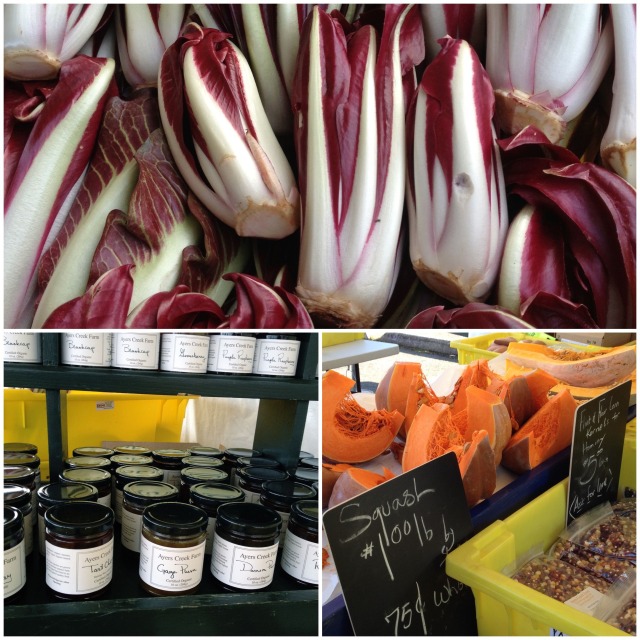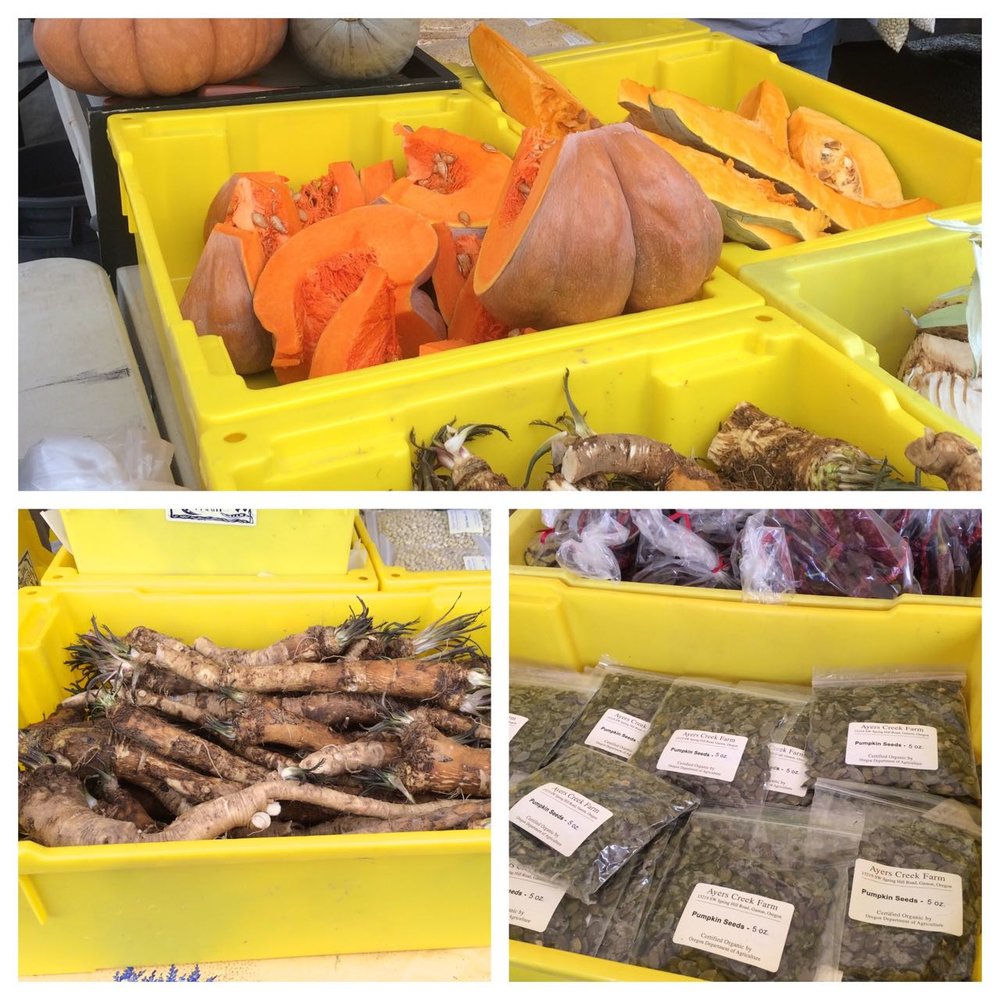 Happy New Year. We will be at the Hillsdale Farmers' Market this Sunday, the 8th of January. The market opens at 10:00 am, and runs until 2:00 pm.
Happy New Year. We will be at the Hillsdale Farmers' Market this Sunday, the 8th of January. The market opens at 10:00 am, and runs until 2:00 pm.
Somehow or another, Friends of Family Farmers has us on the list as one of their regular winter InFARMation speakers. Last summer, when Michelle Knaus asked if we would speak again in 2012, we thought it would be interesting to expand on the ideas in the "Of Cabbages and Seed" essay. Rebuilding a Toyota forklift as a topic first crossed our mind, but we are missing a few critical photos and it is a bit of a hassle bringing the machine to Portland, so second choice prevails. Here is a brief synopsis of the presentation:
"For most gardeners and farmers, January is the month when the seed catalogues arrive and we can begin planning for the next growing season. For some, the planning process is an on-going, year-round exercise because they produce some or all of their own seed, tubers and bulbs. At Ayers Creek Farm, Carol and Anthony Boutard maintain robust on-farm seed production in addition to harvesting crops for food. In this month's presentation, Anthony will describe the challenges and rewards of producing seed, as well as other methods of propagating crops."
The presentation is this Tuesday, 10th of January. InFARMation convenes at Holocene at the corner of SE Morrison and 10th (1001 SE Morrison). Doors open around 5:30, for those who want to pick up a brew and a bite to eat. The presentation and questions run from 6:30 to 8:00. The event always brings in an engaging group of people.
Here is what we will have:
Grains: Frumento (soft red wheat), Jet Barley (naked), Roy's Calais Flint and Amish Butter cornmeal and whole kernels for hominy. We will have pickling lime and instructions on hand if you need them.
Popcorn: Amish Butter.
Legumes: Chickpeas, favas and beans.
Roots & Tubers: Once again, our root selection is limited this week. The ankle's on the mend. Rutabagas and sweet potatoes are certain; no ankle needed for them. Abel, who helped us at the market in early December, will do what he can on Saturday, after he gets home at noon from his winter job at our neighbor's nursery.
Winter Squash: Sibley and Musquee, whole or by the slice. Having cured for four months in a warm, dehumidified room, the squash is now at its peak. Concentrated sunshine from last summer.
Greens: Chicories, chervil, rocket, mustard, cress, kale, collards, cabbage. December left the greens a big haggard, but we will bring in the best. The plants will rebound as the days lengthen.
Preserves: Full selection.
Every year, there is one fruit that refuses to fall into line. This year, it is the red currant that jelled but did not set up firmly. The flavor is excellent and complex, but the texture is closer to a sauce than a traditional preserve. Our kitchen work was spot on, after cooking it sheeted beautifully and gave every indication of a good set, so that is not the problem. The only explanation is that we may have harvested the currants later than normal, and the fruits' pectin levels were lower as a result. We don't add pectin and usually we get a reasonable set. We know we live dangerously on this score, but we would rather enjoy the fruits' full flavor than dull their spritely nature with pectin from other sources.
_______________________________________________________
The Vegetables of Vinegar & Salt
The Ancient Romans classified vegetables by the method of preparation. The olera are the pot herbs, customarily cooked, from which we get that word often floating at the tips of our tongues, olericulture, the growing of vegetables for the kitchen. Acetaria are the vegetables the Romans consumed raw with vinegar (acetic acid), oil and salt. Interestingly, in a linguistic departure from the Romans, the modern European languages, from English to Armenian, from Spanish to Swedish, focus on the historically more valuable ingredient, the salt, in describing the preparation and use of these vegetables. Giving us salad, sallad, salade, salata, salat, ensalada, insalata &c.
John Evelyn, the 17th century English gardener and author of several books, planned a grand encyclopedic work on gardening. As the project foundered and age caught up with him, Evelyn reluctantly published parts of the work separately. Acetaria: A Discourse of Sallets (1699) is devoted to the salad; the work is a blend of scholarship, practicum and advocacy.
Unwilling to sign a loyalty pledge to Oliver Cromwell, the Lord Protector of England, the young Evelyn travelled through Europe, returning home with the restoration of the monarchy. Those years spent in Spain, Holland, France and the Italian states gave him a deep appreciation for the salad as the foundation of good health, and as an art form in its own right. Written in the Baroque period, the book exhibits the period's paradox of complex brevity, especially as Evelyn assumes the reader is his peer with a working knowledge of Greek and Roman authors. Much as today's young Latinos comfortably alternate between English and Spanish in conversation, Evelyn slips in Latin or Greek words and phrases on regular basis. Still, peeling aside the arcane spelling and grammar, along with the unfamiliar and oblique references, Acetaria is a book very much in line with our 21st century sensibilities and a pleasure to read.
The first section of the book details over seventy wild and domesticated plants suitable for use in a salad. Many are familiar to modern readers and are included at various times in the Ayers Creek salad mixes. The inventory is lightened by Evelyn's droll humor. For example, under sage, he notes: "In short, 'tis a plant endu'd with so many and wonderful properties, as that the assiduous use of it is said to render men immortal: we cannot therefore but allow the tender summities of the young leaves; but principally the flowers in our cold sallet; yet so as not to domineer." And his dismissive assessment of spinach as a salad ingredient still rings true: "of old, not used in sallets, and the oftener kept out the better." Even today, growers bulk up salad mixes with spinach, so cheap and easy to grow, yet a poor use of this fine green best cooked. The acrid flavor of the raw spinach must be softened by the use of cream or cheese-based concoctions akin to sauces rather than a true salad dressing.
Evelyn concludes the inventory by warning that the gathering of salad greens is no job for a fool. He disparages old rules of thumb for determining what greens are edible, and lists deadly plants that may mislead an ignorant collector. He also dismisses the prescriptive guidance of fellow Englishman, the herbalist Nicolas Culpepper, in determining when to harvest greens based on astrology, counseling instead to look at the quality of greens and "judge of their vertues by their own complexions." His punchy confidence is endearing.
Before Karen and Frank Morton veered into the seed business, their Wild Garden salad greens were cherished by Portland restaurants. We love hearing Cathy Whims describe the careful attention the Mortons paid to preparing the ever-changing mixture of greens, every leaf perfect, delivered in a damp muslin bag. Evelyn demanded the same attention for his mixture; "let your herby ingredients be exquisitely cull'd and cleans'd of all worm-eaten, slimy, canker'd, dry, spotted or in any ways vitiated leaves." He specifies spring water for washing and, after draining, swinging them gently in a coarse napkin to draw off excess moisture.
The carefully gathered greens need the finest couture de cuisine. For oil in the dressing, he commends omphacine pressed from olives native to the Republic of Lucca, now a province of Italy and still producing superb olives. Olive oil had a range of uses and grades, including lighting and lubrication, as well as food. Omphacine is the first pressing of green olives, what we call, implausibly, "extra virgin" today. For the contrasting acid, the best wine vinegar is specified, though lemon and the tart juice squeezed from verjus grapes also meet his approval. If that special grape type is not available, the freshly squeezed juice from other small, unripe grapes will do. For salt, he favors the "brightest bay grey-salt," what is sold today as fleur de sel and sel gris. The seasonings are English mustard, preferably from Tewksberry, and pepper (black or white). The yolk of a freshly laid egg, boiled moderately hard, is allowed as desired.
He finishes up with the tools needed. These include a willow or osier basket with partitions to separate the various salad greens as they are collected so the correct proportions are used, a silver knife to trim them, and a porcelain or Delft-ware bowl for serving. The iron knife, pewter and silver bowls in use at the time would leave the salad with an unpleasant metallic flavor. In his attention to detail and proportion in preparing and presenting his salad, Evelyn has no rival even among the most fussy modern chefs and gardeners.
The latter half of Acetaria deals with seasonality and health, and what we refer to "industrial food" today. Evelyn inveighs against the flaccid vegetables raised in urban hotbeds prepared from over-rich stable muck and other filth collected from the city streets, favoring instead the healthy vegetables grown in rich humus of the countryside and hedgerows. He also disparages "forwarding," pushing the vegetable and fruit growth outside of their natural seasons and into inferior quality. He promotes the merits of a diet of vegetables. Evelyn was not a vegetarian per se; he was an ardent lover of vegetables and a southern diet, what we refer to as the Mediterranean diet. He advocated eating mostly plants, and was appalled by the slaughter methods in London's abattoirs, much in the same spirit as Michael Pollan pushes us to think about our food's origin and quality. However, he was not wantonly dogmatic, so he leaves the question of whether salad should come before or after the savory dishes convincingly explored and learnedly unresolved, as it still is more than three centuries later.
In addition to the original 1699 edition, Acetaria has been reprinted at least four times. In 1934, the Women's Auxiliary of the Brooklyn Botanic Garden published the complete work in an edition of 1,000 copies, nicely bound with hand cut signatures. This version is available electronically on Gutenberg (www.gutenberg.org/files/15517/15517-h/15517-h.htm). Still Point Press of Dallas, Texas published a numbered edition of 1,000 on high quality French paper (1985) along with a few illustrations, bound with a leather spine. Unfortunately, this handsome edition leaves out the Greek and Latin passages and the margin notes, and the artsy illustrations have no botanical merit. A 1996 version published by Prospect Books, now in paperback (2005), retains the whole text and translates the Greek passages, a more satisfactory approach. Finally, The Grand Salad (Peacock Vane, Isle of Wight, 1984) is a book based on passages from Acetaria. Sadly, it is hard to read as it is handwritten in a calligraphic style. The work also has egregious deletions and some additional dry text that adds nothing to Evelyn's original, despite its good intentions.
Good reading and see you all Sunday,
Carol and Anthony Boutard
Ayers Creek Farm
 The ringing cowbell announcing the opening of the Hillsdale Farmers Market at 10:00 AM tomorrow also heralds another installment of last summer's sunshine carefully stored by nature in the first instance, and by us in the second.
The ringing cowbell announcing the opening of the Hillsdale Farmers Market at 10:00 AM tomorrow also heralds another installment of last summer's sunshine carefully stored by nature in the first instance, and by us in the second.


